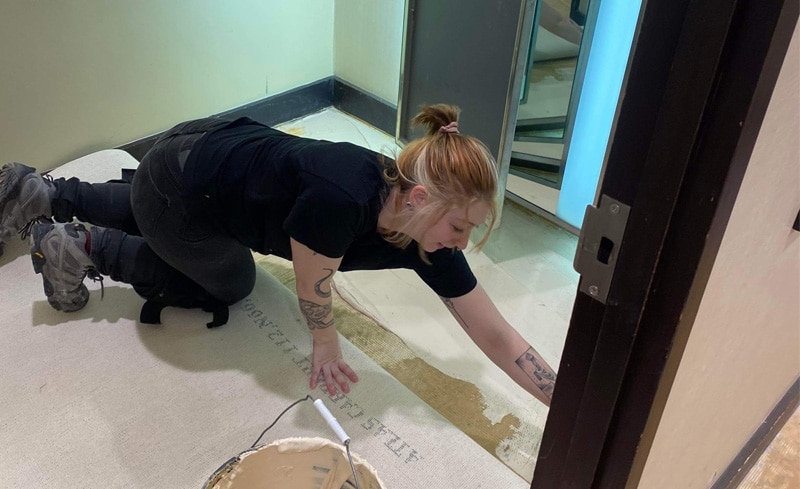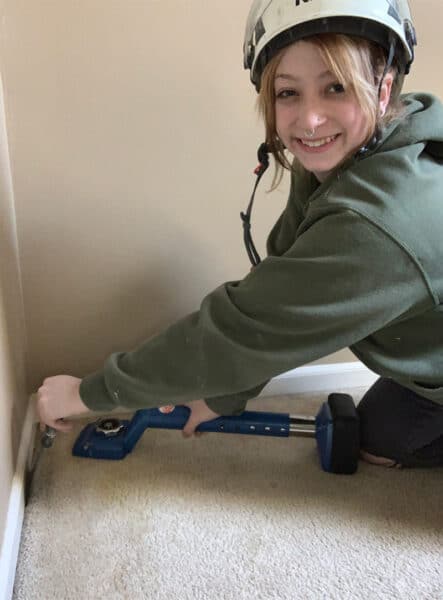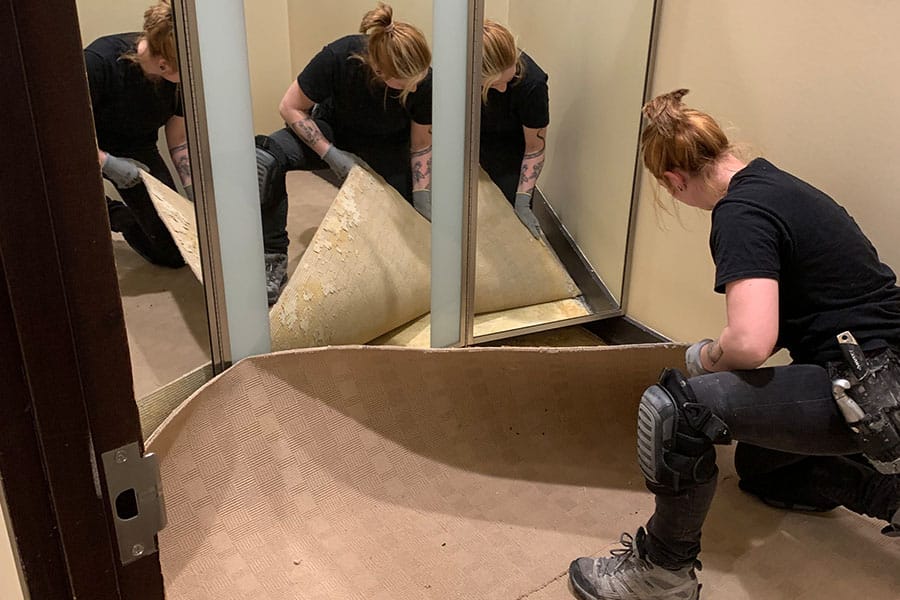Growing up, Abbey Agius helped her father around the house, soldering pipes and laying sheetrock with him as they maintained the family home. Her father’s occupation was in sales, but around the house, he was a tradesman. And in a house full of daughters, Abbey was the one who loved the work. That’s how she discovered early on that she wanted to work in the construction trades.
To get on the path to achieve her goal, Agius attended Sussex County Technical School in New Jersey. She originally entered the school’s welding program, motivated by her cousin who works as an underwater welder. Agius ultimately decided welding wasn’t for her, but her interest in working in a trade hadn’t diminished.
Today, Agius, 22, is a fifth-year apprentice and member of Local 251, a union representing floorlayers throughout the Atlantic region. She works on construction projects across multiple states through her employer, Re:Source New Jersey.
While men in Agius’ family inspired her to join the trades, she’s the role model now. It’s a role she takes seriously for a new generation of young women, a growing number of whom are seeing construction work as a viable, attractive career. Agius is on the steering committee of her local chapter of Sisters in the Brotherhood (SIB), an organization within the United Brotherhood of Carpenters (UBC).
As a mentor, Agius recruits and helps young women find their path to the skilled trades. She understands the impact it has on girls to see women working in a trade. “It’s really cool to see younger generations starting to figure out that we belong in the trades and that there is a place for us,” Agius said. “They see more women joining the trades and think, ‘Well, if they can do all that, why can’t I?’”
Laying the foundation
Despite knowing she wanted to work in a skilled trade, Agius’ first job after high school was as a waitress. Her mother pushed her back toward starting a career. “You can’t waitress forever,” her mother told her.

Influenced by her positive experiences learning carpentry at Sussex County Tech, Agius began calling around to unions to see what opportunities were available for a 17-year-old interested in carpentry. Agius quickly discovered the Carpenters Apprentice Ready Program (CARP), an eight-week, pre-apprenticeship program focused on bringing women and minorities into the trade.
Agius largely credits CARP and SIB for her success. “When I came in, I didn’t know anything,” she said. “They really helped me get where I wanted to go.”
Life on the jobsite
Agius loves her work and the sense of accomplishment that comes with each job. Being a role model is also a bonus.
“I like knowing I’ve actually made something,” she said. “I look at buildings and think, ‘I did this.’ It makes my family proud, too. I point out buildings I’ve worked on to my sister and she has an appreciation for the trades now, too. When she has kids, she can say, ‘Your aunt does this.’”

Working every day on jobsites does more than put Agius in the position as role model that motivates girls and other women to explore construction jobs. It normalizes women on the jobsite for everyone. “As more women are joining trade unions, the guys get used to seeing us every day. They see us working as hard as them,” Agius said.
Even as women in construction become more common, Agius’ presence has raised some eyebrows. Her crewmates have all been welcoming, but she said they sometimes express concerns about whether she can physically handle some lifts or carry certain things. In response, Agius has been known to throw a couple of 70-pound bags of patch on her shoulders and say, “I’ve been telling you guys I can lift this. Like, that’s how much my niece weighs and I throw her in the air.”
Agius tells the story of when she took her first delivery: “The truck driver drove up and took one look at me and couldn’t understand why they sent a 4’11’’ girl to move 100-pound materials. I remember his face when he watched me move pallets by myself and was able to carry things that weighed as much as I did.”
These conversations open broader discussions about safety on the jobsite. “Everyone has their limits,” Agius said. “Everyone knows even if you can lift it, that doesn’t mean you should. Some guys wear back braces to withstand the work. Sometimes the job needs a two-person lift. Everyone wants to make it home safe.”
Moving forward
Agius’ next goal is to become a foreman and run her own crew by the time she’s 25. She’s seen a few women in a foreman’s role at jobsites, but has never worked for one—not yet, anyway. Agius’ employer has the same goal for her and has already sent her to a one-day, union-run foreman training course, she said.
Agius’ other goal over the next few years is to take an even larger role with SIB. She currently helps plan and take part in the group’s public outreach campaigns and has personally brought five women into apprenticeship programs. Agius talks about the vital role SIB has played in her career development. The organizational support doesn’t stop at recruiting more women into skilled trade training; SIB continues to support their growth throughout their career.
“All the sisters get together for a quarterly meeting,” Agius said. “We make sure we’re all doing OK. I have the numbers for lots of the girls, so I can also shoot them a message to see how they’re doing. We all keep in contact to make sure we’re all good and share what’s happening.”
Agius has accomplished a lot in her young career. As she finishes up her apprenticeship, Agius will certainly set more goals—both for her career development and for growing the ranks of women in construction. “It’s crazy empowering to see that you can do this work,” she said. “We’re going to be building stuff forever, and construction is a great place for young women.”











